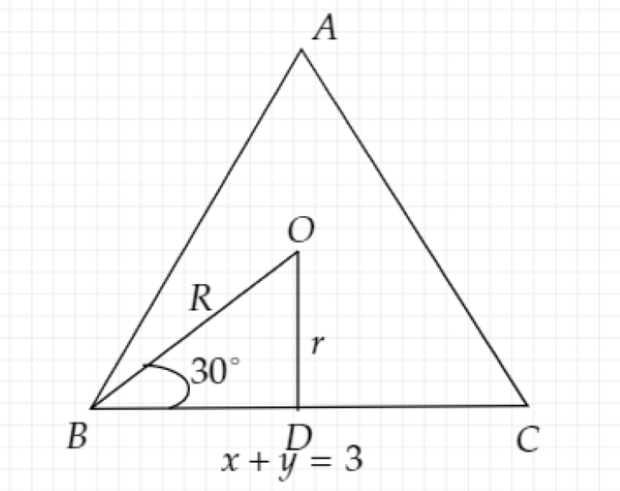
Let the centroid of an equilateral triangle $ABC$ be at the origin. Let one of the sides of the equilateral triangle be along the straight line $x + y = 3$. If $R$ and $r$ be the radius of the circumcircle and the incircle respectively of a triangle $ABC$. Then what is the value of $R + r$?
A. $2\sqrt 2 $
B. $3\sqrt 2 $
C. $7\sqrt 2 $
D. $\dfrac{9}{{\sqrt 2 }}$
Answer
219.3k+ views
Hint: First, use the formula of the perpendicular distance between a point and a line to find the length of the radius of the incircle. Then use the relation between the radius of the circumcircle and the incircle of an equilateral triangle, and find the radius of the circumcircle. In the end, add the values of the radius of the circumcircle and the incircle of an equilateral triangle to get the required answer.
Formula Used:
The perpendicular distance between a point $\left( {p,q} \right)$ and a line $ax + by + c = 0$ is:
$d = \left| {\dfrac{{ap + bq + c}}{{\sqrt {{a^2} + {b^2}} }}} \right|$
The relation between the radius of the circumcircle and the incircle of an equilateral triangle is: $R = 2r$
Complete step by step solution:
Given: The origin is a centroid of an equilateral triangle $ABC$.
One of the sides of the equilateral triangle is along the straight line $x + y = 3$.
$R$ and $r$ be the radius of the circumcircle and the incircle respectively.

Image: An equilateral triangle ABC with a centroid (0, 0)
The perpendicular distance between the origin and a line $x + y = 3$ is the radius of incircle.
Now apply the formula of the perpendicular distance between a point and a line.
The length of radius of the incircle is,
$r = \left| {\dfrac{{0\left( 1 \right) + 0\left( 1 \right) - 3}}{{\sqrt {{1^2} + {1^2}} }}} \right|$
$ \Rightarrow r = \left| {\dfrac{{ - 3}}{{\sqrt 2 }}} \right|$
$ \Rightarrow r = \dfrac{3}{{\sqrt 2 }}$
We know that in an equilateral triangle, the length of the radius of the circumcircle is twice the length of the radius of the incircle.
So, $R = 2r$.
Substitute $r = \dfrac{3}{{\sqrt 2 }}$ in the above equation.
$R = 2\left( {\dfrac{3}{{\sqrt 2 }}} \right)$
$ \Rightarrow R = \dfrac{6}{{\sqrt 2 }}$
Therefore,
$R + r = \dfrac{6}{{\sqrt 2 }} + \dfrac{3}{{\sqrt 2 }}$
$ \Rightarrow R + r = \dfrac{9}{{\sqrt 2 }}$
Option ‘D’ is correct
Note: The distance between the orthocenter of a triangle and the side of the triangle is the radius of the incircle of the triangle. For an equilateral triangle, the radius of the circumcircle is the same as the diameter of the incircle of the triangle.
Formula Used:
The perpendicular distance between a point $\left( {p,q} \right)$ and a line $ax + by + c = 0$ is:
$d = \left| {\dfrac{{ap + bq + c}}{{\sqrt {{a^2} + {b^2}} }}} \right|$
The relation between the radius of the circumcircle and the incircle of an equilateral triangle is: $R = 2r$
Complete step by step solution:
Given: The origin is a centroid of an equilateral triangle $ABC$.
One of the sides of the equilateral triangle is along the straight line $x + y = 3$.
$R$ and $r$ be the radius of the circumcircle and the incircle respectively.

Image: An equilateral triangle ABC with a centroid (0, 0)
The perpendicular distance between the origin and a line $x + y = 3$ is the radius of incircle.
Now apply the formula of the perpendicular distance between a point and a line.
The length of radius of the incircle is,
$r = \left| {\dfrac{{0\left( 1 \right) + 0\left( 1 \right) - 3}}{{\sqrt {{1^2} + {1^2}} }}} \right|$
$ \Rightarrow r = \left| {\dfrac{{ - 3}}{{\sqrt 2 }}} \right|$
$ \Rightarrow r = \dfrac{3}{{\sqrt 2 }}$
We know that in an equilateral triangle, the length of the radius of the circumcircle is twice the length of the radius of the incircle.
So, $R = 2r$.
Substitute $r = \dfrac{3}{{\sqrt 2 }}$ in the above equation.
$R = 2\left( {\dfrac{3}{{\sqrt 2 }}} \right)$
$ \Rightarrow R = \dfrac{6}{{\sqrt 2 }}$
Therefore,
$R + r = \dfrac{6}{{\sqrt 2 }} + \dfrac{3}{{\sqrt 2 }}$
$ \Rightarrow R + r = \dfrac{9}{{\sqrt 2 }}$
Option ‘D’ is correct
Note: The distance between the orthocenter of a triangle and the side of the triangle is the radius of the incircle of the triangle. For an equilateral triangle, the radius of the circumcircle is the same as the diameter of the incircle of the triangle.
Recently Updated Pages
In a game two players A and B take turns in throwing class 12 maths JEE_Main

The number of ways in which 6 men and 5 women can dine class 12 maths JEE_Main

The area of an expanding rectangle is increasing at class 12 maths JEE_Main

If y xxx cdots infty then find dfracdydx A yxy 1 B class 12 maths JEE_Main

Chemical Properties of Hydrogen - Important Concepts for JEE Exam Preparation

JEE General Topics in Chemistry Important Concepts and Tips

Trending doubts
JEE Main 2026: Application Form Open, Exam Dates, Syllabus, Eligibility & Question Papers

Derivation of Equation of Trajectory Explained for Students

Hybridisation in Chemistry – Concept, Types & Applications

Understanding the Angle of Deviation in a Prism

Understanding Collisions: Types and Examples for Students

Understanding Atomic Structure for Beginners

Other Pages
JEE Advanced Marks vs Ranks 2025: Understanding Category-wise Qualifying Marks and Previous Year Cut-offs

How to Convert a Galvanometer into an Ammeter or Voltmeter

Understanding Centrifugal Force in Physics

JEE Main Marking Scheme 2026- Paper-Wise Marks Distribution and Negative Marking Details

Degree of Dissociation: Meaning, Formula, Calculation & Uses

Understanding Electromagnetic Waves and Their Importance




